Home Decor
7 Creative Ways to Style White Brick Wall Decor
Transform your space with these 7 creative ways to style a white brick wall, from monochromatic chic to bold color blocking and more.
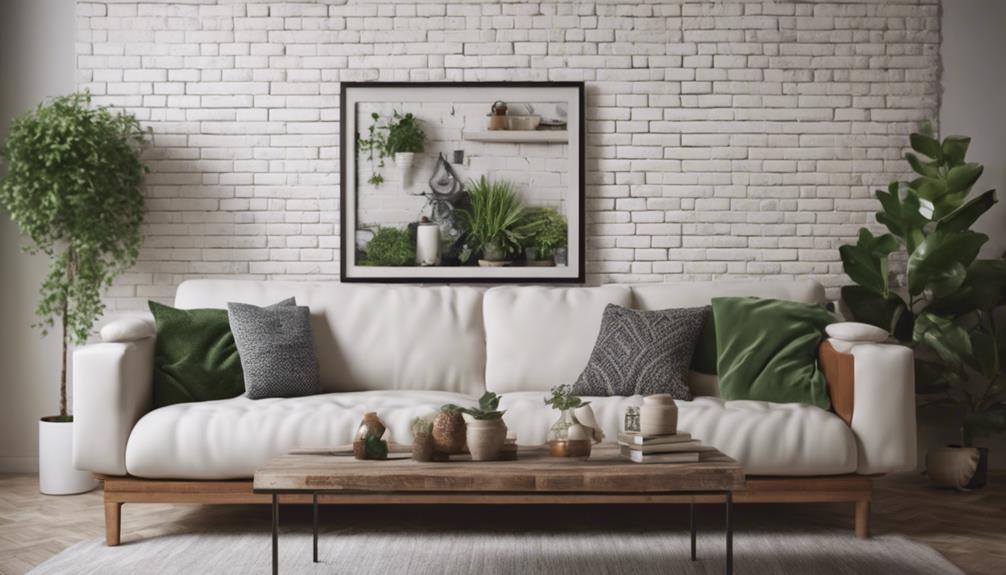
You've got a blank canvas with your white brick wall, and now it's time to get creative! Consider a monochromatic chic look with matching white furniture and decor, or bring in some natural beauty with botanical prints and earth tones. Industrial chic is also an option, with metal accents adding depth and contrast. For a softer vibe, try pairing soft pastel hues with your white brick wall, or add some vintage charm with distressed frame displays and rustic wooden accents. Want more ideas? Explore greenery and brick fusion, bold color blocking, and elegant decor ideas to take your space to the next level.
Key Takeaways
• Incorporate texture with white brick walls and complement with white furniture, decor, and textiles for a clean, modern look.
• Add a natural touch with botanical prints, earth tones, and nature-inspired decor elements for a soothing atmosphere.
• Mix industrial chic with metal accents, shelving units, and lighting fixtures against white brick walls for a dynamic design.
• Soothe the senses with soft pastel hues that enhance the light, airy feel of white brick walls, creating a calming oasis.
• Create a unique look by pairing white brick walls with bold color blocking, vintage decor, or lush greenery for a visually appealing contrast.
Monochromatic Chic With White Brick
By embracing a monochromatic color scheme, you can create a clean and modern look with white brick walls as the focal point. This chic aesthetic is achieved by using a single color scheme, like all white, to create a cohesive and harmonious atmosphere.
To prevent the space from feeling flat or boring, incorporate texture with white brick walls, adding depth and visual interest to your monochromatic design. By using varying shades of white, you can create a sense of depth and visual interest in your white brick wall decor.
In a monochromatic space, white furniture, decor, and textiles will complement your white brick walls perfectly, creating a cohesive look that exudes modern design. The beauty of monochromatic chic with white brick walls lies in its versatility, allowing you to easily integrate different styles and accents for a timeless design.
With a monochromatic color scheme, you can focus on the texture and beauty of your white brick walls, creating a clean and modern space that's both stylish and sophisticated.
Nature-Inspired Accent Walls
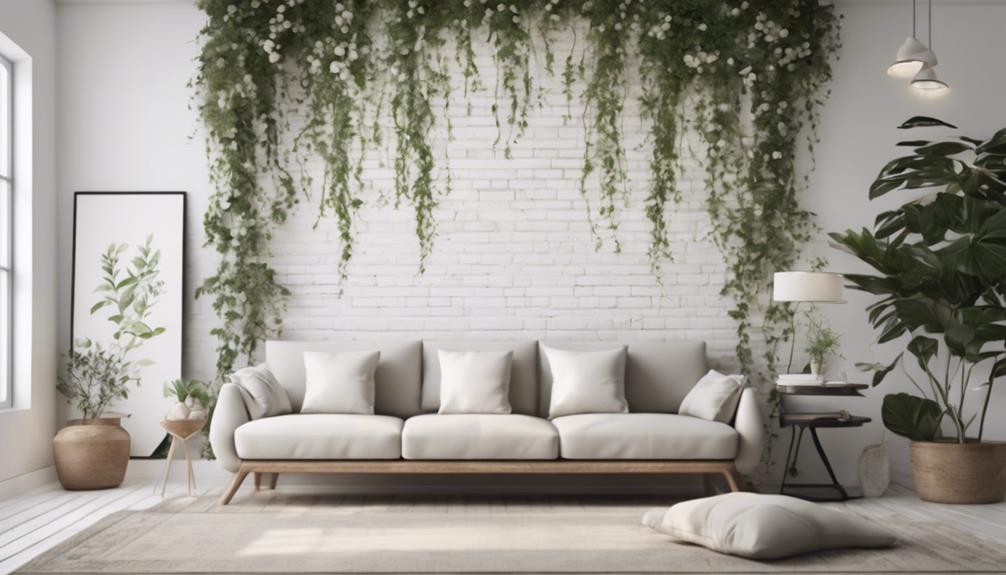
As you explore the world of nature-inspired accent walls, you'll find that incorporating elements like botanical prints and earth tones can instantly evoke a sense of serenity and connection to the outdoors.
By combining these elements with your white brick wall, you'll create a harmonious blend of natural and industrial elements that's both visually striking and calming.
Botanical Prints Galore
What's the easiest way to infuse your white brick wall with a dose of natural beauty, and instantly elevate your space's ambiance? The answer lies in botanical prints! These stunning additions can transform your white brick wall into a nature-inspired accent wall that exudes freshness and serenity.
To create a vibrant and diverse look, incorporate a variety of botanical prints featuring:
- Delicate leaves that add a touch of subtlety to your space
- Vibrant flowers that burst with color and energy
- Tropical motifs that transport you to a lush paradise
- Wild botanicals that bring an air of whimsy to your decor
Earth Tones Unite
Unifying your white brick wall with earth tones creates a soothing atmosphere, and you can effortlessly achieve this by incorporating greens, browns, and blues into your decor. These natural hues complement the white brick beautifully, creating a calming ambiance that invites relaxation.
To enhance the earthy feel, incorporate nature-inspired decor elements like plants, wood furniture, and rattan accessories. You can also use earth tones in textiles such as throw pillows, rugs, and curtains to tie the room together with the white brick accent wall. The result is a harmonious balance that creates a cozy and inviting atmosphere in the space.
To further enhance the earthy and organic theme, consider adding nature-inspired artwork or photography to the white brick wall. By doing so, you'll create a space that feels connected to nature, perfect for unwinding and recharging.
Industrial Chic With Metal Accents
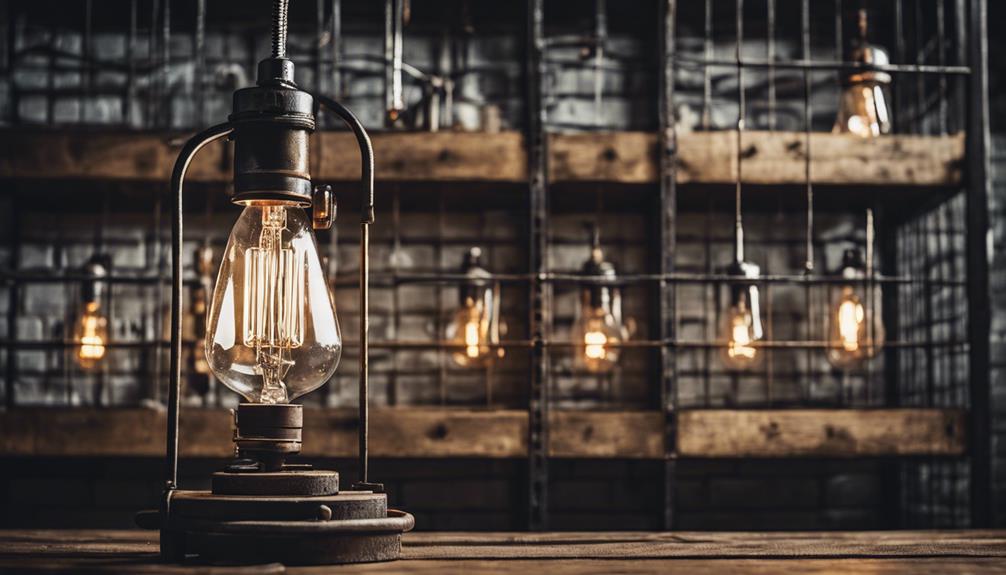
You can instantly elevate your white brick wall decor by incorporating industrial chic elements, particularly metal accents, to create a bold and contemporary atmosphere. This style is all about embracing the raw, urban aesthetic of industrial spaces and bringing it into your home decor.
By incorporating metal accents, you can add a touch of allure to your white brick wall, creating a unique and engaging visual contrast.
To achieve this look, consider the following:
- Choose metal finishes wisely: Opt for brushed nickel, iron, or copper to create a cohesive industrial chic look with your white brick backdrop.
- Add metal shelving units: Incorporate metal shelves, frames, or mirrors to add depth and contrast to your white brick wall, enhancing the industrial aesthetic.
- Mix metal textures: Combine smooth stainless steel or rough wrought iron with your white brick wall for a dynamic and edgy design.
- Industrial lighting fixtures: Use metal lighting fixtures to create a bold, industrial statement in your space.
Soft Pastel Hues and Brick
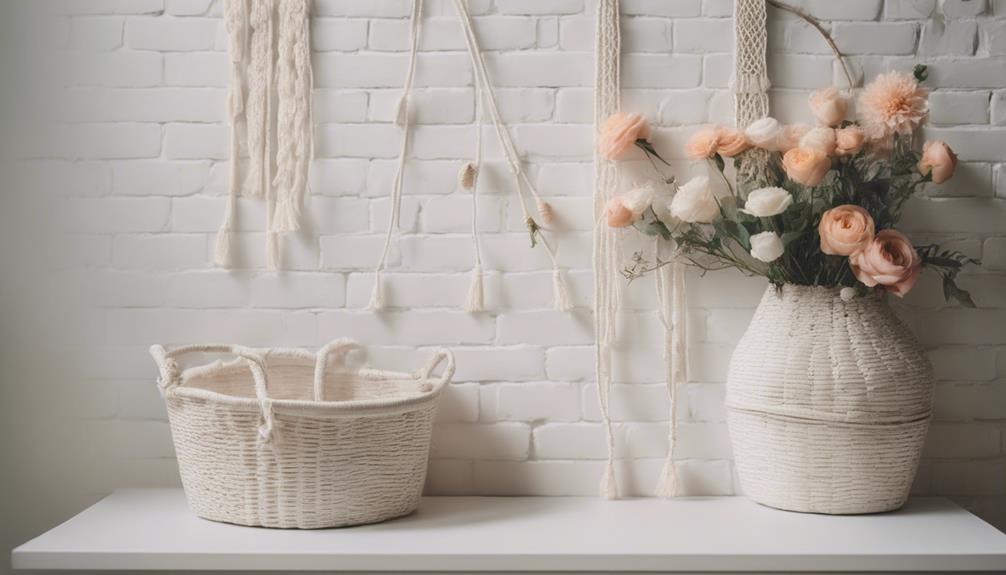
By introducing soft pastel hues into your white brick wall decor, you can create a soothing ambiance that exudes warmth and femininity, a stark contrast to the industrial chic look you've just explored. Soft pastel hues like blush pink, baby blue, and mint green complement white brick walls beautifully, creating a soft and soothing ambiance against the texture of white brick.
When paired with white brick, pastel hues add a touch of femininity and warmth to the space, perfect for a serene and cozy atmosphere. The light and airy feel of white brick walls is enhanced by pastel hues, creating a subtle and elegant contrast in home decor.
As an interior design element, soft pastel hues against white brick walls can elevate your space, making it feel more inviting and relaxing. By incorporating these hues into your white brick wall decor, you'll create a calming oasis that's perfect for unwinding after a long day.
Vintage Decor on White Brick
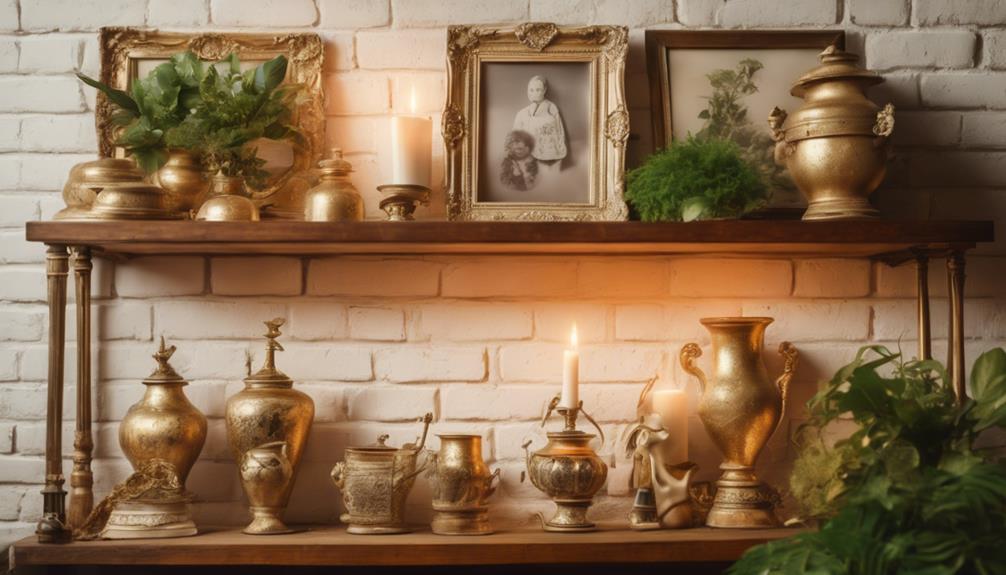
As you explore the world of vintage decor on white brick walls, you'll discover that incorporating unique display pieces can elevate the overall aesthetic.
Consider using distressed frame displays to add a touch of nostalgia, or incorporating rustic wooden accents to bring warmth to the space.
Distressed Frame Displays
Distressed frame displays on white brick walls breathe new life into vintage decor, elevating the space with a charming blend of nostalgia and rustic charm. You can create a unique and personalized display that showcases your cherished memories and art pieces. By incorporating vintage frames, you add a nostalgic and eclectic touch to your white brick wall decor.
Here are some ways to make the most of distressed frame displays:
- Contrasting Beauty: The contrast between distressed frames and white brick walls adds visual interest and depth to the decor.
- Character Enhancement: Incorporating antique frames enhances the character and personality of the white brick backdrop.
- Rustic Charm: Distressed frames on white brick walls create a vintage and rustic charm in the space.
- Personalized Touch: Vintage decor on white brick walls offers a unique and personalized way to showcase cherished memories and art pieces.
Rustic Wooden Accents
You can introduce rustic charm and warmth to your white brick wall decor by incorporating rustic wooden accents, which create a charming contrast against the clean, modern backdrop. By adding reclaimed wood shelves or a distressed wooden coffee table, you'll create a cozy atmosphere that invites relaxation.
To take it a step further, incorporate vintage decor items like a weathered wooden ladder or antique wooden frames, which will add character and warmth to the space.
A mix of white brick walls and rustic wooden accents can evoke a cozy, cottage-like atmosphere in any room. Consider adding a wooden bench with storage baskets or a wooden console table to enhance the rustic charm of the white brick wall decor.
Vintage decor pieces like an old wooden trunk or wooden wall clock can further elevate the aesthetic appeal of a room with white brick walls. By combining these elements, you'll create a unique and inviting space that's perfect for relaxation and conversation.
With rustic wooden accents, you can add warmth and personality to your white brick wall decor, creating a cozy retreat that's all your own.
Faded Floral Patterns
With faded floral patterns, you can infuse your white brick wall decor with a touch of vintage romance, creating a soft, nostalgic atmosphere that's both whimsical and elegant. This unique decor style combines the rustic texture of white brick walls with delicate floral motifs, resulting in a one-of-a-kind look that exudes vintage charm and romantic ambiance.
To achieve this look, you can use:
- Wallpaper: Add a touch of elegance with vintage-inspired floral wallpaper designs that complement your white brick walls.
- Stencils: Use floral stencils to create a subtle, distressed look that adds depth and character to your walls.
- Hand-painted designs: Commission a local artist or try your hand at painting delicate floral patterns directly onto your white brick walls.
- Mix and match: Combine different patterns and designs to create a unique, eclectic look that reflects your personal style.
Greenery and Brick Wall Fusion
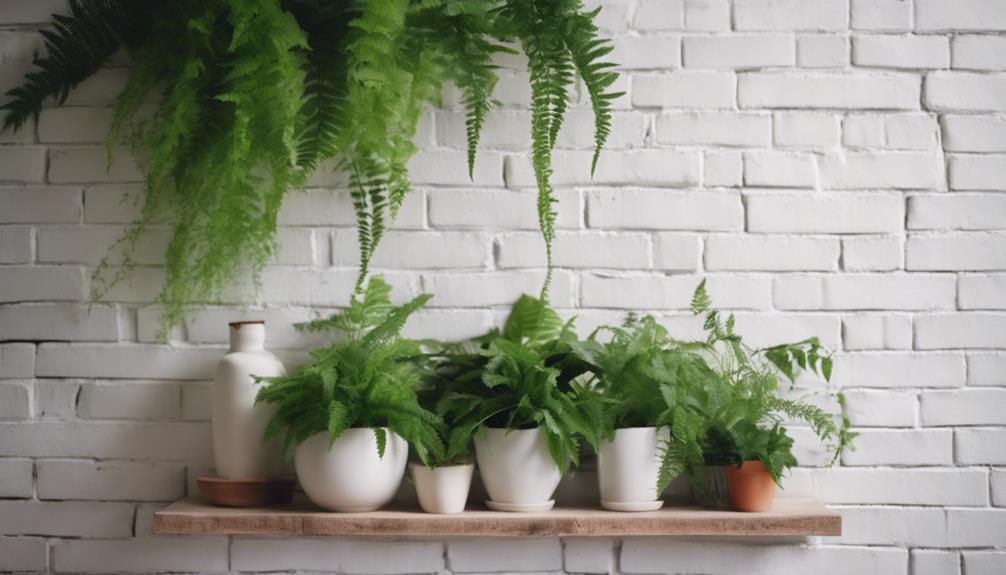
Frequently, incorporating lush greenery against white brick walls can transform a space, adding a fresh and vibrant contrast that revitalizes the entire room.
As you combine greenery with white brick, you'll notice how the natural, organic look enhances the overall aesthetic appeal of your interior wall.
The fusion of greenery and white brick creates a soothing atmosphere, perfect for unwinding after a long day. To take it up a notch, pair your greenery with brown leather accents, which will add warmth and coziness to the space.
The brick accents will subtly complement the greenery, creating a visually appealing contrast. Remember, the key is to strike a balance between the natural and industrial elements.
Bold Color Blocking With Brick
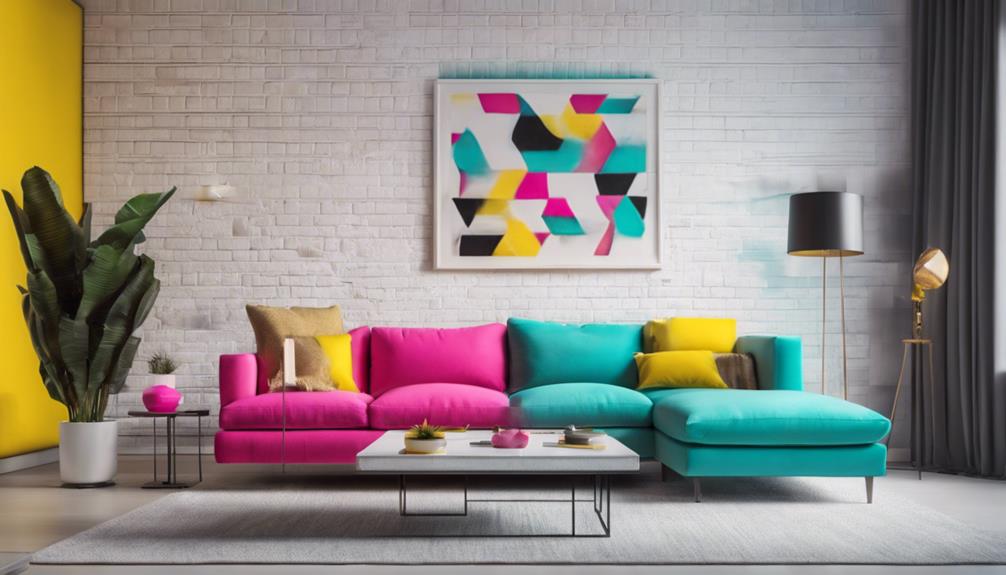
To add a burst of personality to your space, pair your white brick wall with bold, vibrant hues that create a striking contrast and make the wall pop. This bold color blocking technique can elevate your modern home's style and create a statement piece. Here are some tips to get you started:
- Choose bold accent colors: Vibrant hues like teal, mustard yellow, or deep red can create a striking contrast with your white brick wall.
- Incorporate color blocking: Paint sections of the brick wall in different hues to add a modern and artistic touch.
- Opt for complementary furniture: Choose furniture and accessories in colors that complement the bold hues you've chosen to enhance the visual impact.
- Experiment with patterns and textures: Geometric patterns, textures, and shapes can add depth and visual interest to your space.
Frequently Asked Questions
What Looks Good on a White Brick Wall?
What looks good on a white brick wall? You'll be surprised at how versatile this backdrop is!
Bright and colorful decor pops against it, while greenery and brown leather furniture add a bohemian touch.
Artwork and contrasting bedding stand out beautifully, and the texture of the bricks enhances the overall decor style.
You can even create a cozy atmosphere with a few carefully chosen pieces.
Whatever your style, a white brick wall provides the perfect canvas for self-expression.
How Do You Make a Brick Wall Interesting?
You're probably thinking that a brick wall is about as exciting as a plain cracker – until you add some flair.
To make a brick wall interesting, you need to add some visual interest. Think of it like a blank canvas waiting for your artistic touch. Try mixing textures by adding wood or metal accents, or strategically placing lighting fixtures to highlight the wall's natural charm.
With a little creativity, your brick wall can go from bland to grand!
How Do You Dress up a Plain Brick Wall?
You're looking to dress up a plain brick wall, and you're not alone! Many people struggle to make this architectural feature shine.
First, start by adding some visual interest with floating shelves or picture frames to display personal items. You can also incorporate plants or hanging baskets to bring in a natural touch.
Next, consider installing sconces or pendant lights to highlight the brick's texture.
What to Do With an Interior Brick Wall?
When considering what to do with an interior brick wall, you have several options. You can choose to leave it exposed, highlighting its natural texture and charm.
Alternatively, you can paint it white to create a modern and airy aesthetic, serving as a neutral backdrop for various decor styles and color schemes.
Conclusion
As you've seen, styling a white brick wall is all about mixing and matching different elements to create a unique look. Remember, 'variety is the spice of life,' and with these 7 creative ways to style your white brick wall decor, you'll be well on your way to creating a space that's truly one-of-a-kind.
So don't be afraid to experiment, combine styles, and make mistakes – after all, it's all part of the design process. Happy decorating!
Vivienne – Your Content Companion Vivienne is your content companion, curating valuable tips, advice, and inspiration to guide you on your home decor journey. From insightful blog posts to informative product descriptions, she’s here to empower you with the knowledge you need to create your dream space.
Home Decor
Dollar Store Spring Cottage Birdhouses
Bring spring charm to your outdoor space with a whimsical birdhouse crafted from just a few simple dollar store supplies.
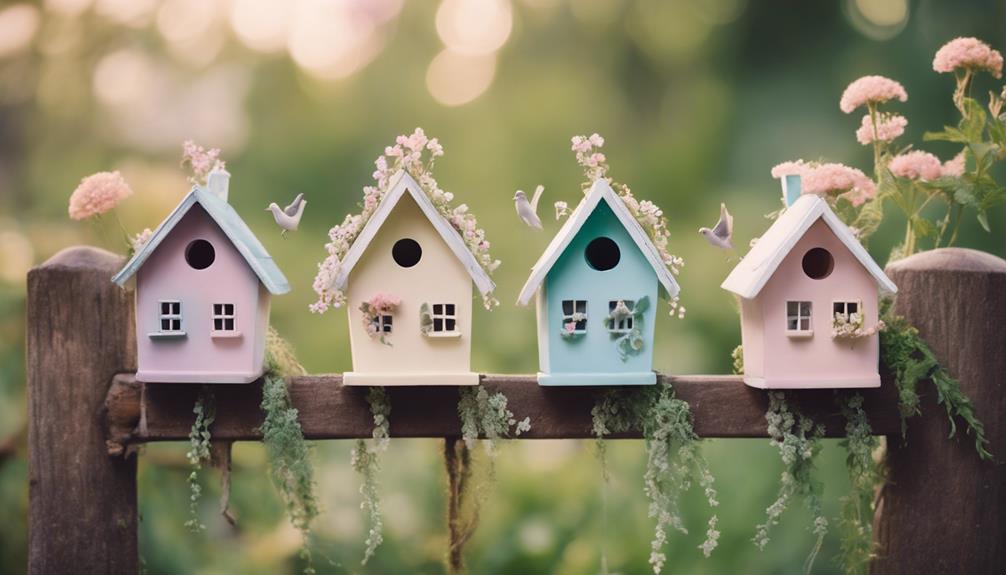
We can create charming spring cottage birdhouses with just a few simple crafting supplies from the dollar store. First, gather essential supplies like birdhouse kits, chalk paint, Mod Podge, and decorative paper. Then, paint the birdhouse base with Waverly chalk paint in agave, adding a vintage look with wax. Add decorative paper details using scrapbook paper and cardstock, and incorporate floral accents for a whimsical touch. Finally, assemble the cottage birdhouse by following the kit's instructions and adding personal touches. As we continue to craft, we'll explore more creative ways to customize our birdhouse and bring spring charm to our outdoor spaces.
Key Takeaways
• Use Dollar Tree birdhouse kits as a base for your spring cottage birdhouse project to save time and money.
• Apply Waverly chalk paint in vibrant colors to create a unique and charming look for your birdhouse.
• Add decorative paper details, such as scrapbook paper and cardstock, to give your birdhouse a touch of personality.
• Embellish your birdhouse with small floral accents, like colorful flowers and greenery, for a whimsical touch.
• Consider adding personal touches, like painting or decorating, to make your birdhouse truly one-of-a-kind.
Gathering Essential Crafting Supplies
As we start on this creative journey, we'll need to gather a few essential crafting supplies to transform our Dollar Store finds into charming spring cottage birdhouses. The first step is to collect the necessary materials, including birdhouse kits, which will serve as the base for our project.
Next, we'll need chalk paint in various colors to give our birdhouses a unique and personalized look. Additionally, we'll require Mod Podge, decorative cardstock, and scrapbook paper to add texture and visual interest to our creations. These supplies will allow us to apply multiple coats of paint, with drying time in between, to achieve a rich and vibrant color.
We'll also need white paint on hand for touch-ups and to create a cohesive look. By gathering these essential crafting supplies, we'll be well on our way to creating beautiful and unique spring cottage birdhouses that showcase our creativity and attention to detail.
Painting the Birdhouse Base
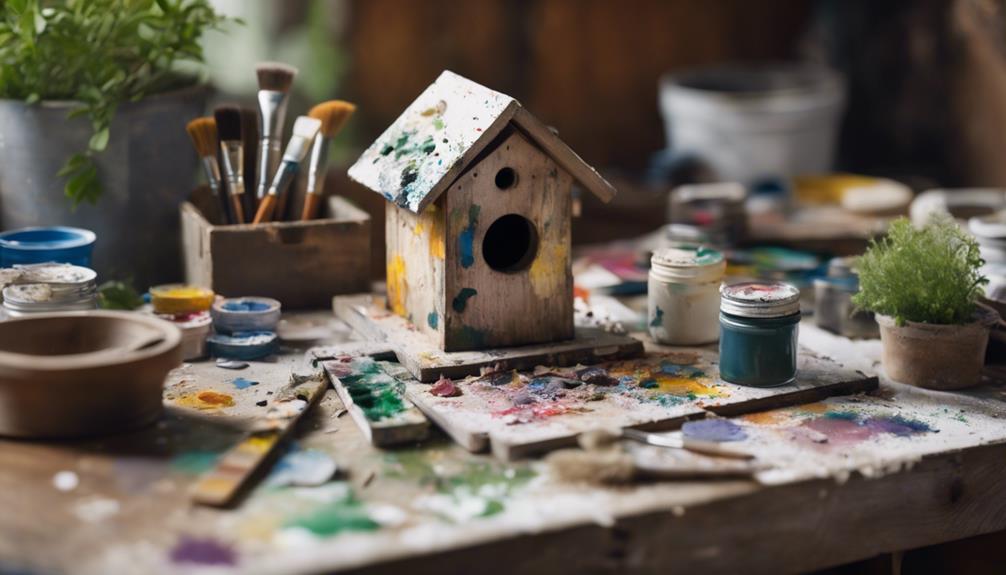
With our crafting supplies in hand, we're ready to bring our spring cottage birdhouses to life by painting the birdhouse base. This is where the magic happens, and our little birdhouses start to take shape.
To achieve a beautiful, solid base color, we'll apply two coats of Waverly chalk paint in agave, making sure that each coat dries completely before applying the next to prevent smudging or streaking.
Here are some essential tips to keep in mind:
- Use a small brush to touch up any areas that may have been missed or need extra coverage with white paint.
- Create a vintage look by applying wax over the dried paint, blending it in for a weathered effect.
- Maintain a smooth and even finish by taking your time and applying the paint and wax carefully to the birdhouse base.
Adding Decorative Paper Details
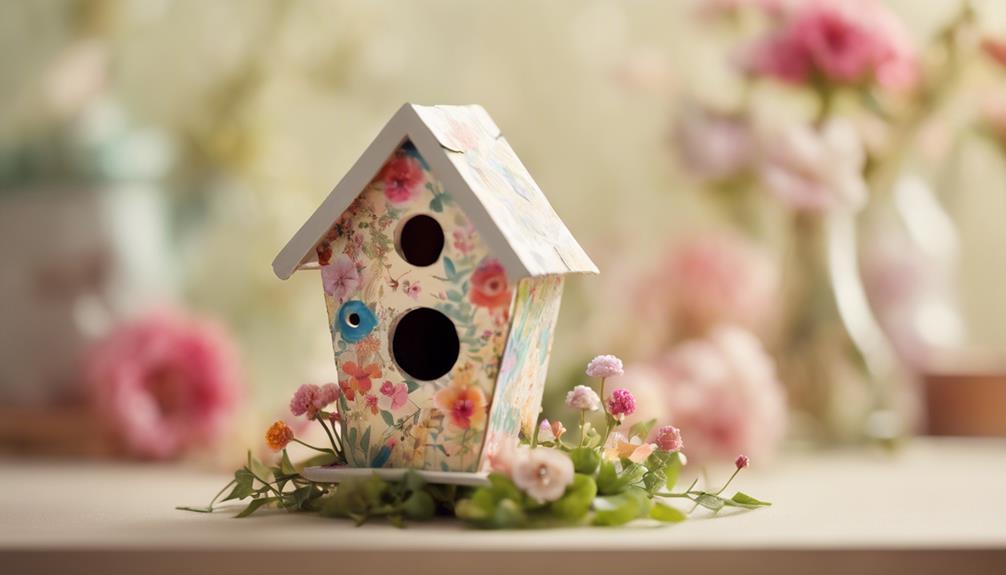
We're adding a personal touch to our spring cottage birdhouses by incorporating decorative paper details that infuse charm and character into these miniature homes. To guarantee this, we're using scrapbook paper and cardstock to create unique patterns and designs that reflect our personal style.
By mixing and matching different papers, we can create a cohesive and visually appealing final result. Next time, we might try adding rickrack trim or other embellishments to enhance the overall look of the birdhouse.
To make sure a secure hold, we'll attach the paper details using Mod Podge or glue. This technique is easy to master, and the results are well worth the effort.
With a little creativity, we can transform a plain birdhouse into a charming cottage that's full of personality. As we work on our birdhouses, we're reminded that it's the little details that make all the difference. By adding decorative paper details, we're creating a one-of-a-kind piece that's sure to delight.
Embellishing With Floral Accents
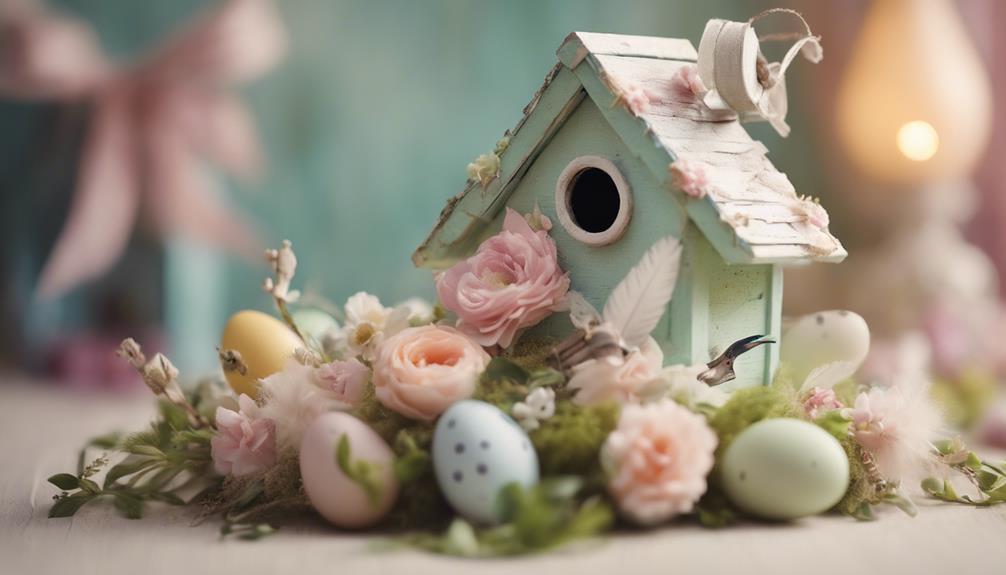
Now that we've added personality to our birdhouses with decorative paper details, let's take them to the next level by introducing a touch of whimsy with small floral accents.
We wanted to make our birdhouses stand out, and what better way to do that than with a splash of colorful flowers and greenery? To enhance our spring cottage birdhouses, we can use a variety of small flowers and foliage to create a natural and eye-catching look.
Here are some tips to keep in mind when embellishing with floral accents:
- Mix and match different flower shapes, sizes, and colors to create a visually appealing design.
- Consider using artificial flowers for a long-lasting and low-maintenance decorative option.
- Secure the floral accents with glue or adhesive to make certain they stay in place and withstand handling.
Assembling the Cottage Birdhouse
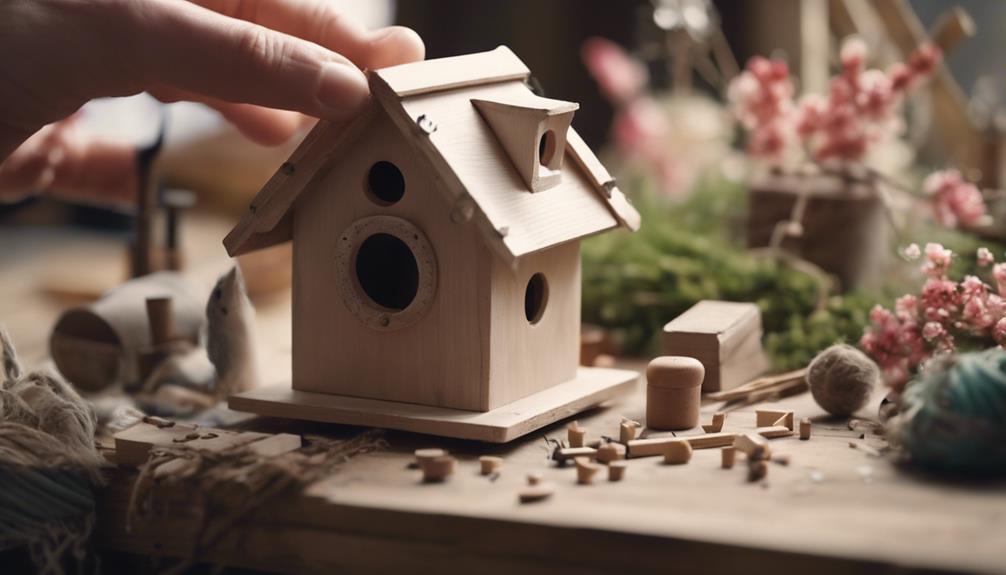
Let's get started on assembling our cottage birdhouse by following the instructions provided in the Dollar Tree birdhouse kit.
As we carefully read through the instructions, we'll make sure to pay attention to the finer details, such as aligning the roof and placing the windows correctly.
We'll use glue or nails to secure the pieces together, ensuring a sturdy construction that can withstand the elements.
As we assemble the birdhouse, we'll also think about adding our own personal touches, like painting or decorating, to make it truly unique.
If we're short on time, we can consider using a ready-made birdhouse from a craft store as an alternative.
Either way, we'll end up with a charming cottage birdhouse that's perfect for spring.
Frequently Asked Questions
Can I Use a Real Birdhouse Instead of a Wooden Birdhouse Shape?
We're wondering if we can ditch the wooden birdhouse shape and use a real birdhouse instead. Honestly, we think it's a great idea – it'll add a touch of authenticity to our DIY project!
Are There Any Alternatives to Decoupage Glue?
As we weave our creative tapestry, we ponder alternatives to decoupage glue, seeking a binding force that's strong yet gentle, like the threads of a spider's web. We find solace in mod podge, a trusty standby, or even white school glue, a humble hero.
How Do I Prevent the Paper Details From Peeling Off?
We prevent paper details from peeling off by applying a clear coat of varnish or Mod Podge after decoupage, ensuring a strong bond and protecting our artwork from wear and tear.
Can I Use Artificial Flowers Instead of Fresh Flowers?
We're wondering if artificial flowers are a viable substitute for fresh ones, and we think they're a great idea! They'll last longer and still add a pop of color, so go for it!
Is It Possible to Make This Project With Kids?
'As we dip our toes into the world of creativity, we ask: can little hands help craft this masterpiece? Absolutely! With patience and guidance, kids can contribute to this project, fostering a sense of pride and ownership.'
Conclusion
As we step back to admire our handiwork, our humble dollar store finds have been transformed into a charming spring cottage birdhouse, reminiscent of a 'hidden gem' tucked away in a lush garden.
The combination of soft hues and delicate details has yielded a whimsical retreat, beckoning birds to take up residence.
With a dash of creativity and some thriftiness, we've proven that beauty can indeed be found on a budget, as the saying goes, 'one person's trash is another person's treasure.'
Alfresco
Is an Alfresco a Verandah? Know the Difference!
Navigate the differences between an alfresco and a verandah to uncover which outdoor living space suits your needs best!
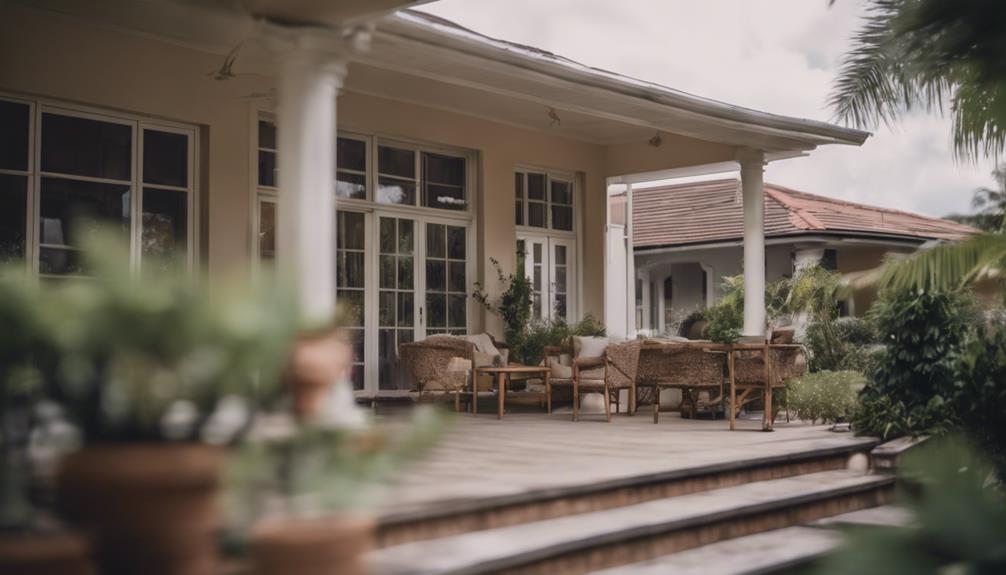
An alfresco and a verandah differ considerably in purpose and design. The alfresco serves as an outdoor dining extension under the main roof, while a verandah is ground-level, providing a covered area for relaxation. Alfrescos are oriented towards modern entertainment, include modern amenities, and attach to the main house's roof. Verandahs, on the other hand, are more traditional, overlooking the front of the house with a separate pitched roof. To explore further distinctions and choose wisely between an alfresco and a verandah, grasp their unique aspects and intended functionalities for your outdoor living needs.
Key Takeaways
- Alfresco serves as a modern outdoor dining and entertainment extension, while a verandah is a traditional covered space for relaxation.
- Alfrescos integrate with the main house roof and offer contemporary amenities, contrasting with verandahs' classic design elements.
- Alfrescos are ideal for outdoor dining year-round with modern finishes, while verandahs provide a sheltered area for socializing.
- Alfrescos use the main house roof for shade and are attached to the house, while verandahs have standalone covered roofs.
- Alfrescos prioritize modern materials like glass and steel for a sleek appearance, while verandahs typically use traditional materials like timber.
Alfresco Area Vs Verandah: Key Contrasts
When comparing an alfresco area to a verandah, the key contrasts lie in their design and intended use. An alfresco area serves as an outdoor extension for dining under the main roof, providing a space for casual meals and gatherings.
On the other hand, a verandah is a covered structure at ground level that connects front and back entrances, offering a place for relaxation and socializing in a traditional architectural style.
The alfresco area is specifically designed for outdoor dining and entertainment, often equipped with sliding doors for protection and to enhance the aesthetic value of a home. In contrast, verandahs are used for small parties and overlook the front of the house, providing a covered area to enjoy the outdoors while being protected from the elements.
While alfrescos seamlessly extend the home's living space, verandahs act as a connection space between indoor and outdoor areas. The alfresco area is commonly associated with modern outdoor living, while verandahs offer a more traditional touch to the architectural design of a house.
Design Variances Between Alfresco and Verandah
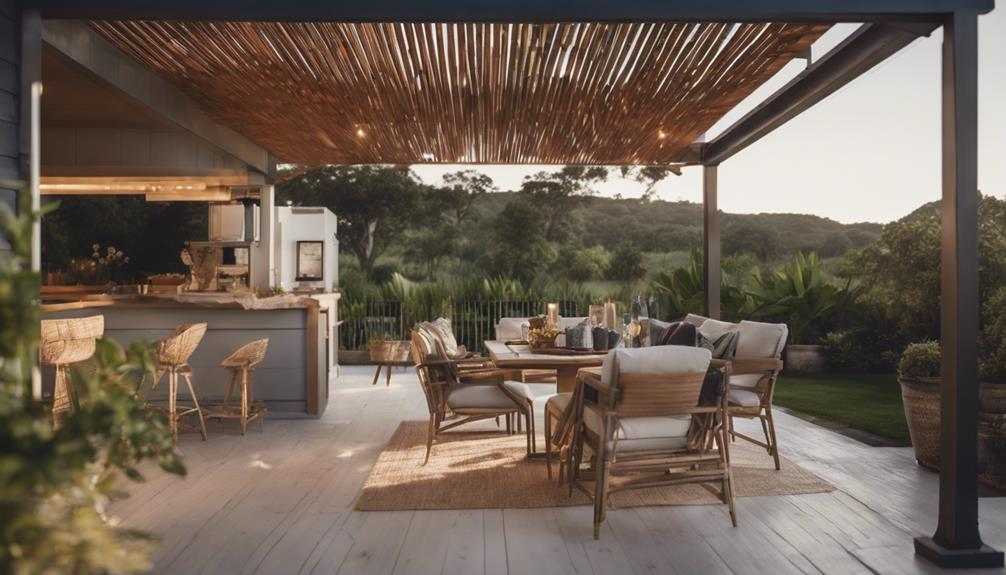
When comparing the design variances between an alfresco and a verandah, it's important to analyze the roof structures, functional spaces, and material selections. The roof structure of an alfresco tends to be integrated into the main house roof, creating a seamless indoor-outdoor flow, while verandahs often feature a separate pitched roof design.
Functional space variations highlight how alfrescos are tailored for dining and entertaining, whereas verandahs serve as sheltered passageways around the house, emphasizing a historical architectural connection.
Material selection variances further distinguish these outdoor spaces, with alfrescos featuring modern amenities and finishes, contrasting with the classic design elements of verandahs.
Roof Structure Differences
In distinguishing between alfrescos and verandahs, one key aspect that sets them apart is their roof structures. Alfrescos typically utilize the main roof of the house for shade, blending seamlessly with the existing architecture. On the other hand, verandahs are standalone covered structures at ground level, having their own distinct roof separate from the main house. To help visualize the differences, refer to the table below:
| Aspect | Alfresco | Verandah |
|---|---|---|
| Location | Attached to the main house | Standalone structure at ground level |
| Roof Structure | Uses the main roof for shade | Has its own covered roof |
| Purpose | Outdoor dining under existing roof | Connects front and back entrances of a home |
| Design | Integrates with house design | Traditional connecting space |
| Size | Often smaller, part of the main structure | Longer and narrower for small gatherings |
Understanding these distinctions can assist in making informed decisions when considering the addition of either an alfresco or a verandah to your property.
Functional Space Variations
For understanding the design variances between an alfresco and a verandah, consider their functional space variations. An alfresco is an outdoor extension of the main living area, designed for modern features like outdoor kitchens and dining areas. It serves as a covered structure, offering protection from the elements year-round and can be partially enclosed for added comfort.
In contrast, a verandah is a more traditional covered structure attached along the front, back, or side of a house, serving as a space between indoors and outdoors. Verandahs are open structures that provide shade and a relaxing outdoor space. Alfrescos are commonly used for outdoor dining and entertaining purposes, while verandahs are ideal for relaxing, reading, or enjoying the surrounding landscape views.
While alfrescos are typically built as extensions of the home under the main roof, verandahs can be freestanding or attached structures with various roof options like flat, skillion, or gable roofs.
Material Selection Variances
If you're considering the design variances between an alfresco and a verandah, the material selection plays an essential role in distinguishing these outdoor living spaces. Alfrescos often incorporate modern materials like glass and steel, giving them a contemporary feel, while verandahs typically utilize traditional materials such as timber for a more classic appearance.
When it comes to design elements, verandahs may include decorative features like fretwork or balustrades for elegance, whereas alfrescos focus on sleek, functional designs. Prioritizing weather resistance and durability, alfrescos commonly use materials like aluminum and composite decking, contrasting with verandahs that may opt for hardwoods like cedar or merbau to achieve a natural aesthetic.
Additionally, alfrescos may integrate high-tech materials like UV-resistant polycarbonate roofing and composite cladding for low maintenance, setting them apart from the more rustic feel of verandahs. The choice of materials significantly impacts the overall style, maintenance needs, and longevity of these outdoor spaces.
Functional Disparities of Alfresco and Verandah
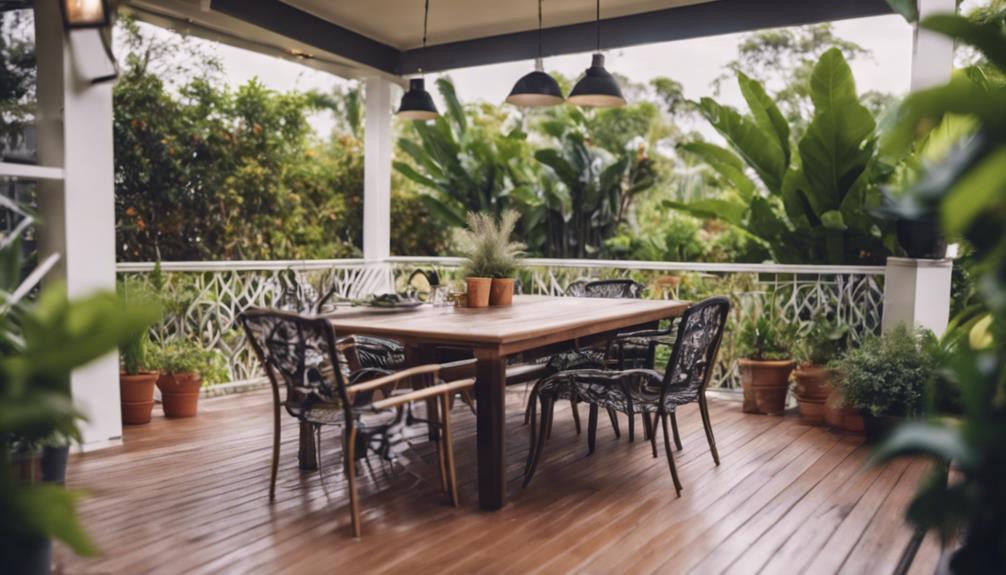
An alfresco and a verandah serve distinct functions within a home, showcasing usage variations and design elements that differentiate the two structures.
Alfrescos are designed to create an integrated outdoor living space under the main roof, often equipped with amenities like outdoor kitchens, ideal for dining and entertainment.
In contrast, verandahs act as covered passageways or social spaces, offering a connecting area between the indoors and outdoors, commonly used for relaxation or to enjoy the front view of the house.
Usage Variations
The functional disparities between alfrescos and verandahs are evident in their distinct usage variations. Alfrescos are primarily designed for outdoor dining and entertaining, creating a space for leisure activities and social gatherings. They offer a seamless extension of the indoor living space, blurring the lines between indoor and outdoor areas. Alfrescos often come equipped with amenities like outdoor kitchens and dining areas to enhance the overall experience.
On the other hand, verandahs serve a simpler purpose, acting as covered pathways or connecting areas within a home. They're typically used for small gatherings or as a relaxation spot, providing shelter and linking different parts of the house. Verandahs prioritize functionality over elaborate design features, focusing on their role as a covered structure rather than a dedicated entertainment space.
Essentially, while alfrescos cater to outdoor living and dining experiences, verandahs serve as practical connectors within a property.
Design Elements
When comparing the design elements of alfrescos and verandahs, it becomes evident that they serve distinct functional purposes in enhancing outdoor living spaces. Alfrescos are designed as outdoor extensions for dining under the main roof, providing a smooth shift between indoor and outdoor areas. They focus on creating a smooth flow, using the main roof for shade and offering protection from the elements year-round. These covered structures not only enhance the aesthetic value of a home but also cater to outdoor dining and entertainment needs.
On the other hand, verandahs are typically at ground level, overlooking the front or back of a house, and are more commonly used for relaxing or enjoying the outdoor view. Their design elements revolve around providing a covered pathway or sitting area. While alfrescos emphasize smooth shifts and outdoor extensions, verandahs prioritize offering a covered space for various activities, albeit with a different aesthetic appeal.
Comparing Alfresco and Verandah Aesthetics
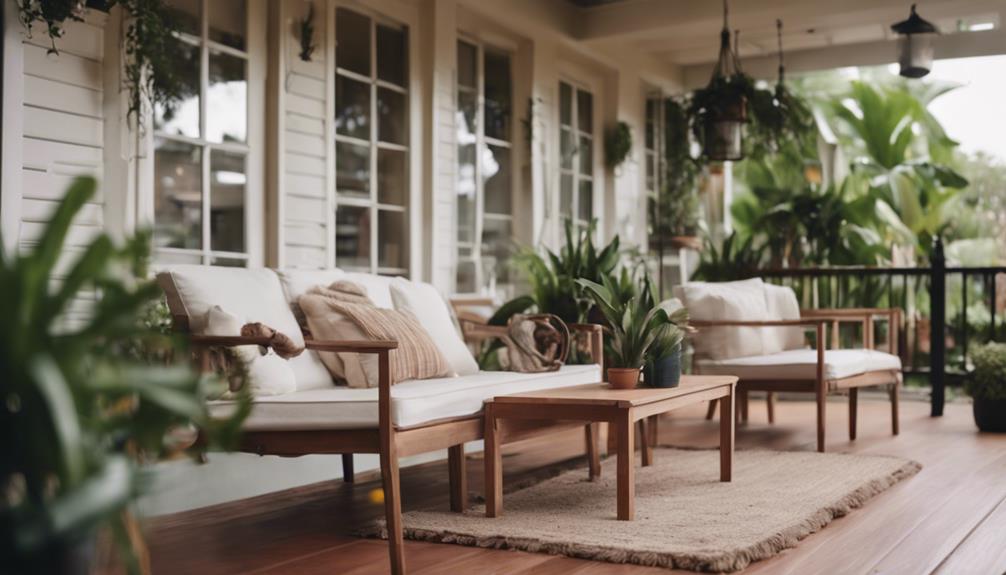
Alfrescos and verandahs present distinct aesthetics that showcase their unique design features and styles. While alfrescos lean towards a modern and sleek appearance, verandahs exude a more traditional and classic charm. The table below highlights some key differences in the aesthetics of alfrescos and verandahs:
| Aspect | Alfresco | Verandah |
|---|---|---|
| Roof Design | Often a part of the main roof structure | Separate roof covering the structure |
| Supporting Columns | Minimal or absent | Typically adorned with columns or posts |
| Architectural Style | Contemporary | Traditional |
Alfrescos tend to prioritize a seamless integration of indoor and outdoor spaces, often featuring sliding doors and a modern appeal. In contrast, verandahs boast a more timeless look with prominent columns and a roof that extends from the main structure. These differences in design elements contribute to the overall aesthetic and feel of each outdoor living space.
Alfresco Vs Verandah: Usage Distinctions
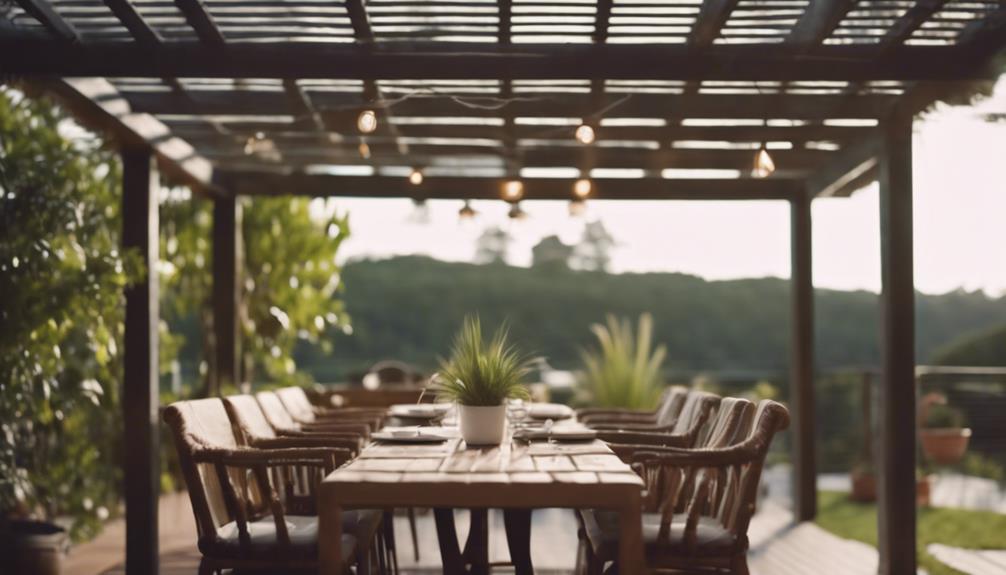
Highlighting the versatile functionality of outdoor living spaces, alfrescos and verandahs offer distinct usage distinctions that cater to different preferences and needs.
Here are some key differences to help you understand how alfrescos and verandahs are used:
- Alfresco:
- An alfresco is an outdoor extension primarily designed for dining under the main roof.
- It enhances the aesthetic appeal of a home and often includes sliding doors for protection during various weather conditions.
- Alfrescos are typically associated with outdoor dining and entertaining spaces, providing a cozy and inviting atmosphere for gatherings.
- Verandah:
- In contrast, a verandah is a covered ground-level structure that connects the front and back entrances of a house.
- Verandahs can be utilized for small gatherings or as relaxing spots overlooking the front of the house.
- They serve as covered pathways or sitting areas along the perimeter of a property, facilitating easy shifts between indoor and outdoor spaces.
Structural Differences: Alfresco Vs Verandah
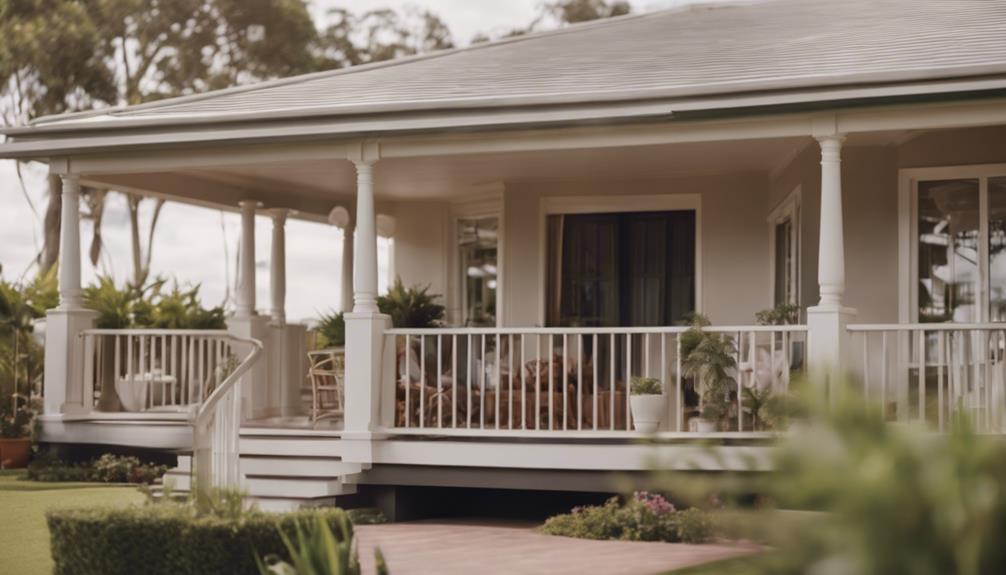
When comparing an alfresco to a verandah, structural differences are evident in the roofing materials used and the level of enclosure. Alfrescos typically feature roofs that are extensions of the main house structure, providing a high level of enclosure with sliding doors for protection.
Verandahs, on the other hand, may have different roofing materials and offer a more open design, often acting as covered walkways or sitting areas.
Roofing Materials Used
Utilizing the main roof of the house for support, alfrescos commonly employ roofing materials such as Colorbond steel or insulated panels. Verandahs, on the other hand, often feature independent roofing materials like corrugated iron or timber shingles.
When considering the roofing materials used in alfrescos and verandahs, several key differences emerge:
- Integration with the Main House: Alfrescos tend to integrate more seamlessly with the main house due to their shared roofing materials, creating a cohesive look. In contrast, verandahs offer a distinct aesthetic appeal by utilizing independent roofing materials.
- Aesthetic Variation: The choice of roofing material for alfrescos or verandahs can have a notable impact on the overall aesthetic of the outdoor structure. Colorbond steel exudes a modern and sleek appearance, while timber shingles provide a more traditional and rustic look.
- Durability and Maintenance: The selection of roofing materials also influences the durability and maintenance requirements of alfrescos and verandahs. Insulated panels offer enhanced insulation and energy efficiency for alfrescos, whereas corrugated iron may require more frequent maintenance for verandahs.
Level of Enclosure
For a clear distinction between an alfresco and a verandah regarding structural differences, consider the level of enclosure each outdoor space provides. An alfresco is typically more enclosed than a verandah, offering walls or privacy screens that provide a sense of coziness and protection. This enclosed structure allows for year-round use, shielding you from the elements while enjoying outdoor dining or entertainment. On the other hand, a verandah is more open, serving as a covered passage from indoors to outdoors. Verandahs are commonly used for relaxation and admiring the surroundings, creating a welcoming entry to your home. To better understand the differences, let's take a look at the comparison table below:
| Aspect | Alfresco | Verandah |
|---|---|---|
| Level of Enclosure | Enclosed with walls or screens | More open with less enclosure |
| Year-round Use | Suitable for all seasons | May be less comfortable in extreme weather |
| Protection | Offers protection from elements | Provides minimal shelter from weather |
| Outdoor Dining | Ideal for outdoor dining experiences | Can be used for light meals or relaxation |
| Entertainment | Great for hosting gatherings and events | Suitable for relaxing and enjoying views |
Alfresco or Verandah: Which to Choose?
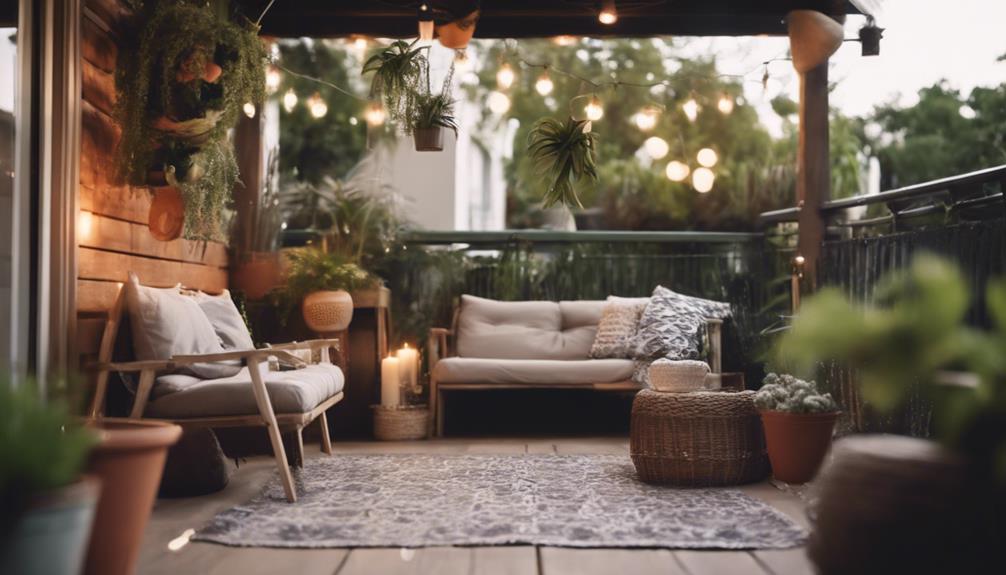
Considering whether to opt for an alfresco or a verandah for your outdoor space can depend on your lifestyle preferences and desired functionality. Both options have their unique characteristics that cater to different needs. Here are some key points to help you make an informed decision:
- Functionality:
- Alfrescos are ideal for adding an outdoor living space that seamlessly connects to your home, perfect for dining and entertaining.
- Verandahs provide a covered area that serves as a connecting space between the indoors and outdoors.
- Design:
- Alfrescos often feature outdoor kitchens, dining areas, and furniture, enhancing the outdoor living experience.
- In contrast, verandahs offer a covered space for relaxation or small gatherings.
- Purpose:
- While alfrescos focus on expanding your living area outdoors, verandahs primarily function as covered walkways or sitting areas.
Consider your lifestyle needs and desired functionality to determine which option best suits your home.
Outdoor Living: Alfresco Vs Verandah
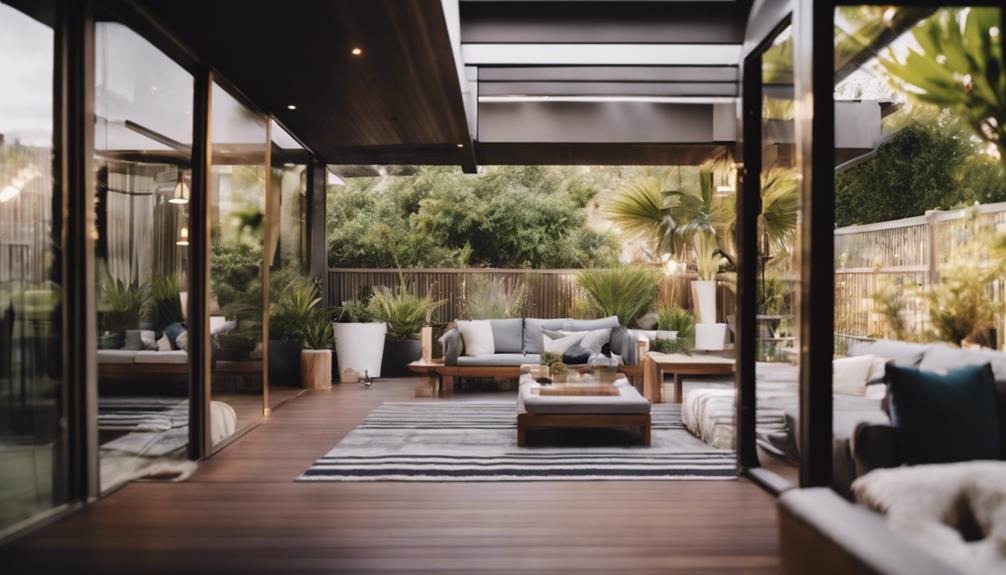
When considering your outdoor living space, it's crucial to understand the specific characteristics of each option. Below is a comparison table highlighting key differences between an alfresco and a verandah:
| Aspect | Alfresco | Verandah |
|---|---|---|
| Location | Connected to the main house | Along the front, back, or side of the house |
| Purpose | Designed for dining and entertaining | Serves as a connecting space between indoors and outdoors |
| Integration | Offers a seamless look with the main house | Can vary in size and shape |
| Features | Often includes sliding doors for protection | Typically has open sides for ventilation |
| Function | Enhances the aesthetic value of the home | Provides a covered area for relaxation and social gatherings |
Understanding these distinctions can help you make an informed decision when planning your outdoor living space.
Alfresco Vs Verandah: Home Value Impact
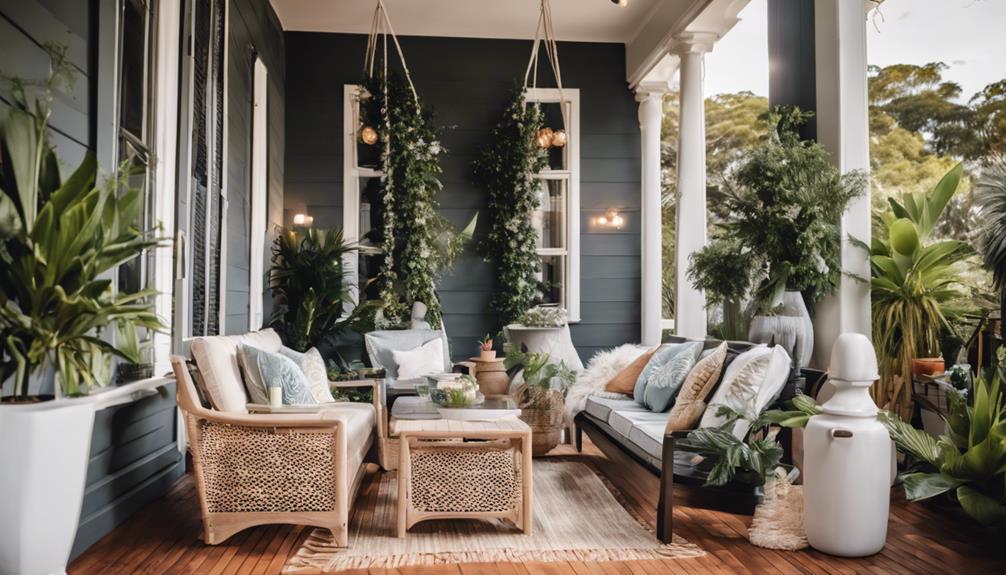
Understanding the impact on home value between an alfresco and a verandah is key when planning your outdoor living space. When considering whether to add an alfresco or a verandah to your home, here are some key points to keep in mind:
- Home Value Increase: Adding an alfresco can potentially raise your home's value by up to 20%, making it a lucrative investment for homeowners looking to increase their property's worth.
- Traditional Charm vs. Modern Appeal: While a verandah typically adds 12-15% to the value of a home, alfrescos are perceived as more modern and luxurious. The choice between the two can depend on whether you prefer traditional charm or modern appeal.
- Buyer Attraction: Both alfrescos and verandahs can enhance curb appeal and attract potential buyers. However, alfrescos, being more contemporary, might have a broader appeal to a modern buyer demographic.
Making the Choice: Alfresco or Verandah
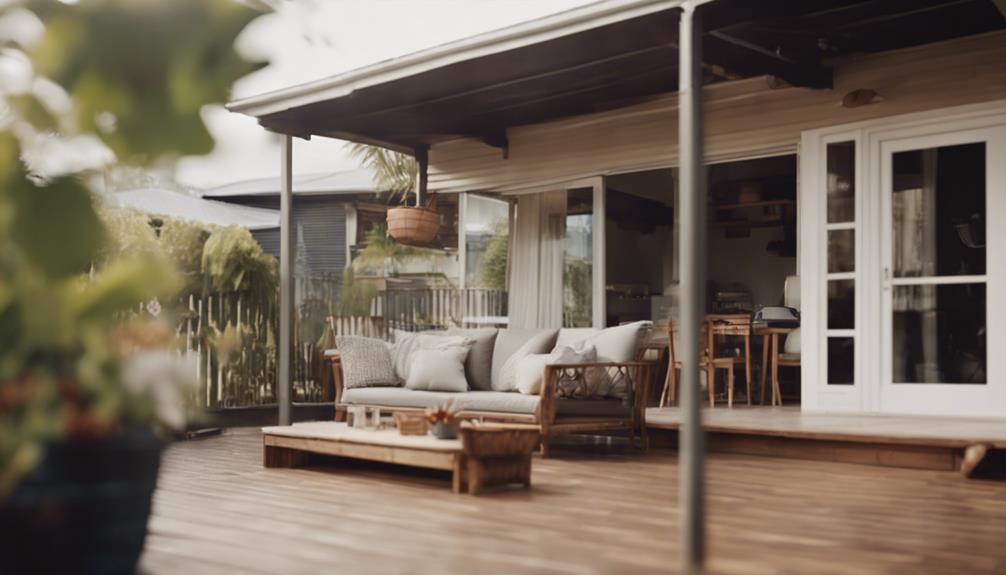
When deciding between an alfresco and a verandah for your outdoor space, consider the primary function and desired aesthetic appeal of each option.
An alfresco is an outdoor living space connected to the main house, offering protection from the elements and customizable features like outdoor kitchens for dining and entertaining.
On the other hand, a verandah is a covered structure typically attached to the front, back, or side of a house, serving as a connecting space between indoors and outdoors, ideal for relaxation and enjoying the view.
The choice between an alfresco and a verandah depends on the function you envision for your outdoor living space. If you prioritize seamless integration with your main house and desire a space for hosting gatherings and meals, an alfresco might be the ideal option.
Conversely, if you seek a covered area for unwinding and appreciating the surroundings, a verandah could better suit your needs. Evaluate your preferences, location, and design goals to make an informed decision that complements your outdoor lifestyle.
Frequently Asked Questions
What Is Considered a Verandah?
When considering what is considered a verandah, think of a covered structure attached to a house, offering a sheltered outdoor space. It serves as an extension of the main roof, providing a cozy connection to the outdoors.
What Is the Difference Between a Veranda and a Verandah?
When distinguishing between a veranda and a verandah, note that they both provide covered outdoor spaces attached to a house. The key difference lies in spelling variations, with "veranda" being more common internationally and "verandah" in Australia.
What Is an Alfresco on a House?
An alfresco on a house is an outdoor living area designed for dining and entertaining. It seamlessly connects indoor and outdoor spaces under the main roof. Alfrescos provide protection from the elements and a cozy ambiance.
Is a Pergola and Verandah the Same Thing?
A pergola and a verandah are not the same thing. A verandah is attached to the main house with a covered roof, while a pergola stands freely with an open slatted roof for climbing plants.
Conclusion
In the end, choosing between an alfresco area and a verandah comes down to personal preference and lifestyle needs. Each option offers distinct design, functionality, and aesthetic features that cater to different outdoor living experiences.
Whether you opt for the open-air appeal of an alfresco or the traditional charm of a verandah, both can enhance your home's value and provide a delightful space for relaxation and entertainment. Make your choice wisely to create the perfect outdoor oasis for your home.
Home Decor
Homemade Bird Nest Crafting: 3 Simple Steps
Prepare to take flight into the world of creative nesting, where natural beauty and personal touches come together in a unique decorative piece.
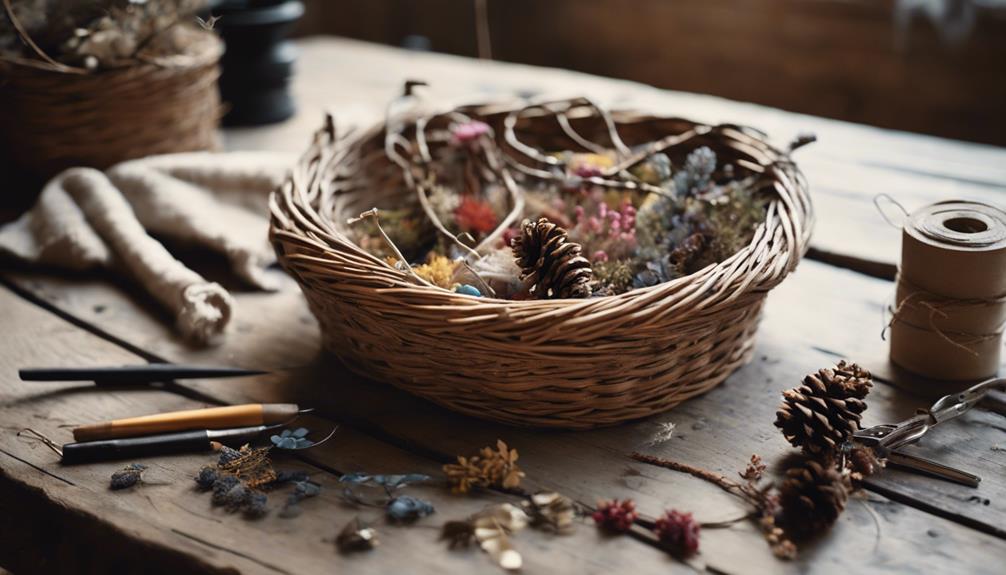
To craft a homemade bird nest, start by gathering natural materials like dried grass, twigs, and leaves from your yard or local parks. Next, mold the nest shape by wrapping angel hair vine filler around a bowl, securing it with thin wire. Finally, add decorative elements like feathers, dried flowers, or small twigs to enhance the natural look. Personalize your nest with ribbons, fabric scraps, or small ornaments to make it unique. With these three simple steps, you'll have a natural haven for birds and a stunning decorative piece for your home – and that's just the beginning of your creative journey.
Key Takeaways
• Gather natural materials like dried grass, twigs, and Spanish moss to mimic the bird's natural environment.
• Create a nest structure by wrapping angel hair vine filler around a bowl and securing it with thin wire.
• Add decorative elements like Easter eggs, feathers, and dried flowers to enhance the natural look.
• Personalize your bird nest with ribbons, fabric scraps, or small ornaments to make it unique.
• Experiment with different elements to unleash your creativity and make your DIY project special.
Gathering Natural Materials
Head outdoors to scour your yard, local parks, or online retailers for natural materials like dried grass, twigs, leaves, and Spanish moss that will give your DIY bird nest an authentic look. This is the first step in making a homemade bird nest that will attract birds to your backyard.
You'll want to gather materials that mimic the natural environment, allowing your DIY nest to blend in seamlessly. As you forage for materials, keep in mind the type of bird you're trying to attract, as different species have unique nesting preferences.
Once you've collected your materials, prepare your workspace by covering it with craft paper, wearing gloves, and working in a well-ventilated area to prevent mess. With your materials and workspace ready, you'll be set to start crafting your DIY bird nest, making it an inviting home for your feathered friends.
Crafting the Nest Structure
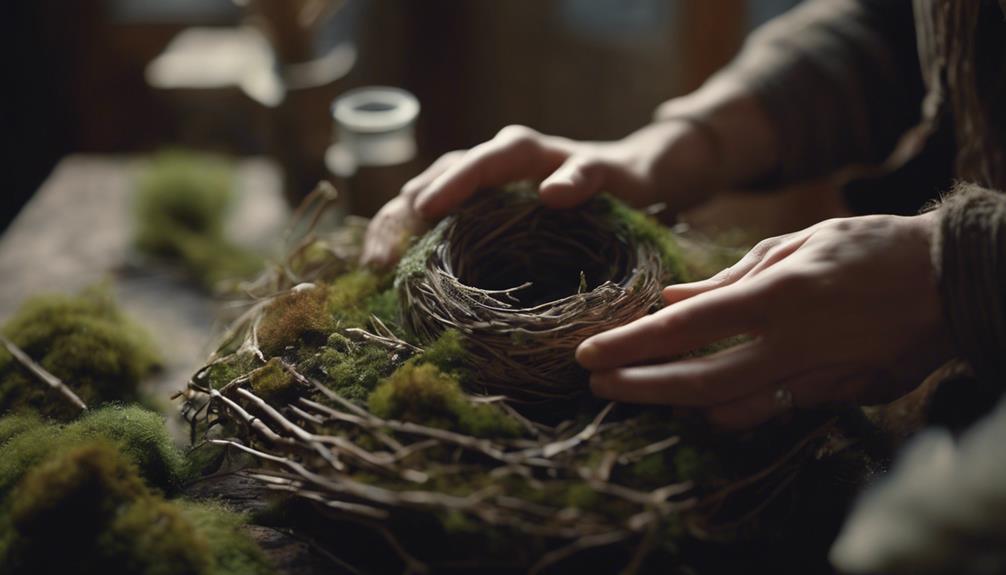
With your natural materials and workspace prepared, you're ready to start crafting the nest structure, the foundation of your DIY bird nest. This is the most essential step in creating a realistic bird nest, as it provides the base shape and form of the nest.
To craft the nest structure, follow these steps:
- Wrap the angel hair vine filler around a bowl to mold the nest shape, using thin wire to secure it in place.
- Continue wrapping the vine filler around the bowl, overlapping the layers to create a sturdy base.
- Secure the sides of the nest together using thin wire, and trim any excess filler.
- Once the nest is formed, carefully remove it from the bowl.
Adding Final Touches
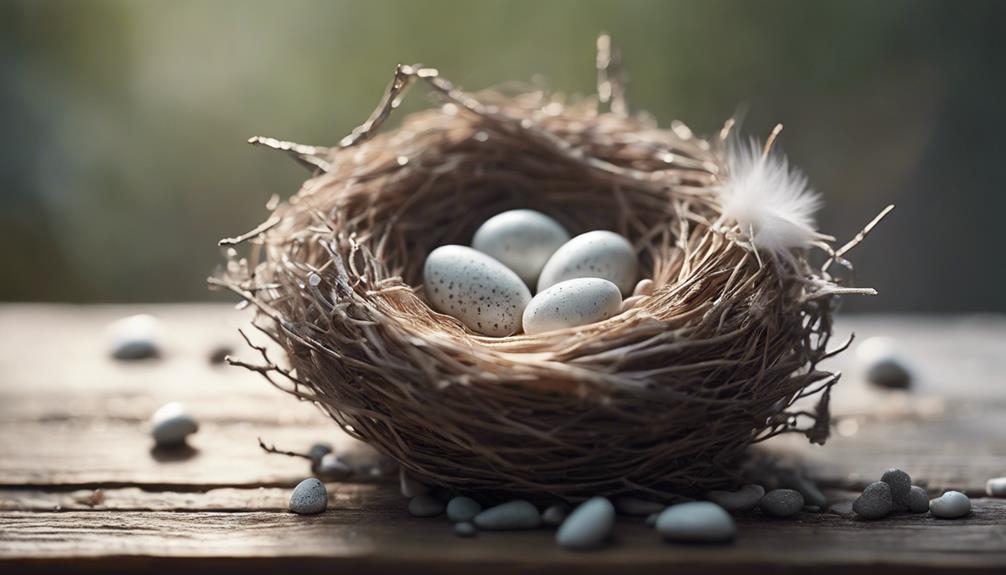
You can now add the perfect finishing touches to your DIY bird nest by incorporating decorative elements that reflect your personal style and flair.
Add a pop of color and texture to your bird nest with decorative Easter eggs or faux bird eggs, which can be easily attached using a hot glue gun.
To enhance the natural look of your nest, incorporate feathers, dried flowers, or small twigs, which will add a touch of whimsy and authenticity to your decoration.
Consider adding a miniature nest or a tiny bird figurine to create a charming and unique centerpiece.
Experiment with different elements like ribbons, fabric scraps, or small ornaments to personalize and customize your bird nest decoration.
Don't be afraid to get creative and try out new ideas – after all, customization is what makes your DIY project truly special.
Frequently Asked Questions
How to Build a Bird Nest Step by Step?
When you're wondering how to build a bird nest step by step, start by gathering natural materials like twigs, grass, and feathers for an authentic look.
Next, use a bowl as a mold to shape the nest and hold it together with thin wire.
How to Make a Craft Nest for Kids?
When you're looking to make a craft nest for kids, start by gathering materials like construction paper, glue, a bowl, and a paintbrush.
Cut the paper into strips and layer them inside the bowl, coated with a glue and water mixture.
Encourage kids to experiment with different colors and textures to create a unique nest, adding details like eggs or birds for a realistic touch.
How Do Birds Build Nests for Kids?
You might wonder how birds build their nests, and it's fascinating to learn about their unique techniques. Birds collect materials like twigs, leaves, and mud, carefully arranging them to create a safe space for their eggs.
Some species weave intricate nests, while others dig simple depressions in the ground. By observing birds build nests, you'll appreciate their remarkable resourcefulness and adaptability in using their surroundings to create homes.
How to Make Birds Nest With Paper?
Are you curious about how to make a bird's nest with paper? You're in luck!
To create a realistic bird's nest, you'll need to cut paper strips about 1/4 inch thick, mix Elmer's glue with water, and arrange the strips criss-crossing inside a bowl lined with plastic wrap.
You can experiment with different colors and textures of paper to create a unique design.
Conclusion
As you carefully place the final twig, your homemade bird nest begins to resemble a cozy little home, a tribute to nature's intricate design.
Like a master weaver, you've intertwined twigs, leaves, and feathers to create a snug sanctuary, a symbol of hope and new life.
Just as the nest cradles its precious cargo, your creativity has given birth to something beautiful, a reminder that even the smallest acts of craftsmanship can hold profound significance.
Vivienne – Your Content Companion Vivienne is your content companion, curating valuable tips, advice, and inspiration to guide you on your home decor journey. From insightful blog posts to informative product descriptions, she’s here to empower you with the knowledge you need to create your dream space.
-

 Craft and Textiles2 months ago
Craft and Textiles2 months ago15 Best Places to Buy Appliances for Your Home – Top Retailers Reviewed
-

 Decorative Throws2 months ago
Decorative Throws2 months agoIs It Better to Dry Clean Blankets?
-

 Vetted3 weeks ago
Vetted3 weeks ago14 Best Personalized Father's Day Gifts for Your Husband – Show Him You Care
-

 Yarn2 months ago
Yarn2 months agoIs Yarn Natural or Manmade? Unravel the Truth
-

 Tableware and Dining Accessories2 months ago
Tableware and Dining Accessories2 months agoWhat Is the Meaning of the Word Tableware
-

 Tableware and Dining Accessories2 months ago
Tableware and Dining Accessories2 months agoWhat Is the Hindi Meaning of Tableware
-

 Craft and Textiles2 months ago
Craft and Textiles2 months ago15 Best Cordless Mowers for Effortless Lawn Care – Top Picks of 2024
-

 Craft and Textiles2 months ago
Craft and Textiles2 months ago15 Best Battery-Powered Leaf Blowers for Effortless Yard Work



















